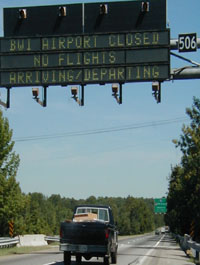| Gridlock Strikes Region in Wake of Airplane Attacks
By Bobby White and Nora Achrati
Capital News Service
Tuesday, Sept. 11, 2001; Web-posted 9 p.m.
 |
|
Area airports closed after
the terrorist attacks. (Photo by Kim Harris)
|
ANNAPOLIS - The three largest airports in the Washington area closed,
traffic snarled as government offices shut down, and Metro trains skirted the heavily damaged Pentagon in the wake of apparent terrorist airplane attacks in the region and New York City.
"Major Problems-Avoid D.C. Metro Area" read the lighted traffic
sign over U.S. Route 50, warning away drivers headed for the District and
Baltimore-bound highways. Heavy traffic severely slowed movement out of
Washington as federal employees abandoned the city.
"It's terrible," said Alaska-bound traveler Henry Walker, who said he was with the
U.S. Air Force."I just came home from Saudi Arabia," Walker said. "We had been hearing about terrorist activities while I was over there, but I had
been thinking that nothing was going to happen there because security
was too tight."
American Airlines flight 77, carrying 58 passengers, four flight
attendants and three pilots, left Washington Dulles International Airport shortly before crashing into one side of the Pentagon building in Arlington, Va.,
around 9:30 a.m. Less than an hour earlier two planes had crashed into the
World Trade Center.
All flights into and out of Dulles, Baltimore Washington International
Airport, and Ronald Reagan National Airport were halted after the Federal Aviation Administration canceled all flights nationwide. It was the first
time the FAA has ordered such a nationwide "ground stop."
Metro rail closed its Pentagon and National Airport stations and
Yellow Line trains were not running on the bridge over the Potomac
River, according to Metro officials.
From Pentagon City, buses to and from Rosslyn,
Va., were added to the
station's regular bus service.
At BWI, passengers rerouted from flights around the country
scrambled to contact relatives, friends and employers to give them the
news: they're alive and safe and won't be leaving the ground. Long lines for pay phones and power outlets formed shortly after the airport closing was announced. Cell phone use skyrocketed around the airport.
Security within BWI tightened significantly: FAA personnel
walked the corridors as bomb-sniffing dogs examined luggage pulled from
delayed and re-routed flights. Police patrolled the interior and
exterior of the main terminal on foot and bicycle.
Most airport shops closed, but a Starbucks and a bar remained
open. Passengers packed both to watch television news updates of the
airplane crashes.
Bruce McKenzie sat outside the coffee shop reading "Crisis 4," a
terrorist novel. He had to leave his plane to Detroit after airlines
were put on alert.
"There isn't much I can do about it," said McKenzie, whose
Detroit office contacted him and said they would get in touch with his
family. "It's awful. If this isn't war, I don't know what is."
Rick Catron boarded his plane to Portland, Ore., but 20 minutes
before it was scheduled for takeoff he and fellow passengers were
instructed to leave the plane.
"I think we all feel the same; just horrible," Catron said as he
stood in a pay phone line.Catron learned train service from BWI had been canceled;
he planned instead to take the airport Super Shuttle to the District.
Authorities began organizing 35 shuttles to make continuous runs
between the airport and the District. Each shuttle carries seven
passengers.
Other stranded passengers flooded the airport's rental-car agency
kiosks, prompting employees to place "Reservation Only" signs outside
their offices.
"We were able to accommodate people at first, but after the large
influx, we weren't able to," said Avis manager Will Miller.
BWI employs about 11,000 full- and part-time employees to help
manage the 53,000 passengers that come through the airport daily. The
airport serves 50 airlines, including American.
Dulles is the largest airport in the region, serving more than 55,000 people on a daily basis and employing
more than 15,000.
All three area airports serve more than 150,000 passengers daily.
Those trying to get to area airports have had about as much
success as those trying to get out. One traveler bound for National
Airport asked a Metro attendant to direct him.
"They're hijacking planes and running them into buildings, and
you're trying to get to the airport?" the attendant replied. "Good
luck."
CNS staff writer Carolyn Taschner contributed to this
report.
Copyright © 2001 University of Maryland College of
Journalism
Top of Page | Home Page
| 
